Experimental Study of Leakage Monitoring of Diaphragm Walls Based on Distributed Optical Fiber Temperature Measurement Technology
Abstract
:1. Introduction
2. Distributed Optical Fiber Sensing Technology
3. Test Set-Up
3.1. Seepage Monitoring Based on DTS
3.2. Model Test Scheme
3.3. Test Process
4. Results and Discussions
4.1. Temperature Change During Monitoring
4.2. Relationship Between Temperature and Flow Velocity
5. Conclusions
Author Contributions
Funding
Conflicts of Interest
References
- Yu, J.L.; Gong, X.N. Spatial behavior analysis of deep excavation. Chin. J. Geotech. Eng. 1999, 21, 24–28. [Google Scholar]
- Zhang, Y.C.; Yang, G.H.; Zhong, Z.H. Discussion on some key problems in soft soil foundation pit design and application analysis of design examples. Chin. J. Rock Mech. Eng. 2012, 31, 2334–2343. [Google Scholar]
- Andersson, P.M.; Linder, B.G.; Nilsson, N.R. Radar system for mapping internal erosion in embankment dams. Int. J. Rock Mech. Min. Sci. Geomech. Abstr. 1991, 43, 11–16. [Google Scholar]
- Carlsten, S.; Johansson, S.; Sworman, A. Radar techniques for indicating internal erosion in embankment dams. J. Appl. Geophys. 1995, 33, 143–156. [Google Scholar] [CrossRef]
- Alain, C.; Benoit, C.; Jean, L. Water leakage detection using optical fiber at the Peribonka dam. In Proceedings of the 7th International Symposium on Field Measurements in Geomechanics, Boston, MA, USA, 24–27 September 2007; pp. 59–70. [Google Scholar]
- Liu, T.; Sun, W.J.; Chen, J. Study on Comprehensive Testing of Lossless Precision Testing for Leakage of Waterproof Curtain in Foundation Pit. In Proceedings of the 2018 GeoShanghai International Conference, Shanghai, China, 27–30 May 2018; pp. 363–372. [Google Scholar]
- Lee, S.J.; Heuidae, L.; Dongsoon, P. Structural-Health evaluation for core zones of Fill Dams in Korea using electrical resistivity survey and no water boring method. J. Korean Geoenviron. Soc. 2015, 16, 21–35. [Google Scholar] [CrossRef]
- Howard, A.D.; McLane, C.F. Erosion of cohesionless sediment by groundwater seepage. Water Resour. Res. 1988, 24, 1659–1674. [Google Scholar] [CrossRef]
- Mainali, G.; Nordlund, E.; Knutsson, S.; Thunehed, H. Tailings Dams Monitoring in Swedish Mines using Self-Potential and Electrical Resistivity Methods. Electron. J. Geotech. Eng. 2015, 20, 5859–5875. [Google Scholar]
- Zhu, P.Y.; Zhou, Y.; Luc, T. Seepage and settlement monitoring for earth embankment dams using distributed sensing along optical fibers. In Proceedings of the 2008 International Conference on Optical Instruments and Technology: Optoelectronic Measurement Technology and Applications, Beijing, China, 16–19 November 2008; pp. 285–294. [Google Scholar]
- Tyler, S.W.; Selker, J.S.; Hausner, M.B. Environmental temperature sensing using Raman spectra DTS fiber–optic methods. Water Resour. Res. 2009, 45, W00D23. [Google Scholar] [CrossRef]
- Khan, A.; Vrabie, V.; Durso, G. Blind source separation techniques for percolation leakage detection in dikes using fiber optic DTS signals. In Proceedings of the 19th International Conference on Optical Fiber Sensors, Perth, Australia, 15–18 April 2008; pp. 355–373. [Google Scholar]
- Barrias, A.; Joan, C.; Sergi, V. A review of distributed optical fiber sensors for civil engineering applications. Sensors 2016, 16, 748. [Google Scholar] [CrossRef]
- Dong, H.Z.; Chen, J.S. Study on groundwater leakage of foundation pit with temperature tracer method. Chin. J. Rock Mech. Eng. 2004, 23, 2085–2090. [Google Scholar]
- Juarez, J.C.; Maier, E.W.; Choi, K.N.; Taylor, H.F. Distributed fiber-optic intrusion sensor system. J. Lightwave Technol. 2005, 23, 2081–2087. [Google Scholar] [CrossRef]
- Minardo, A.; Bernini, R.; Zeni, L. Distributed Temperature Sensing in Polymer Optical Fiber by BOFDA. IEEE Photonics Technol. Lett. 2014, 26, 387–390. [Google Scholar] [CrossRef]
- Saxena, M.K.; Raju, S.D.V.S.J.; Arya, R.; Pachori, R.B.; Ravindranath, S.V.G.; Kher, S.; Oak, S.M. Raman optical fiber distributed temperature sensor using wavelet transform based simplified signal processing of Raman backscattered signals. Opt. Laser Technol. 2015, 65, 14–24. [Google Scholar] [CrossRef]
- Han, Y.W.; Hao, W.J.; Zhang, L.X. Research of distributed optical fiber temperature measurement system based on Raman scattering principle. Semicond. Optoelectron. 2013, 34, 342–345. [Google Scholar]
- Bao, X.Y.; Liang, C. Recent progress in distributed fiber optic sensors. Sensors 2012, 12, 8601–8639. [Google Scholar] [CrossRef]
- Barnoski, M.K.; Jensen, S.M. Fiber waveguides: A novel technique for investigating attenuation characteristics. Appl. Opt. 1976, 15, 2112–2115. [Google Scholar] [CrossRef]
- Hartog, A.H.; Martin, P.G. On the theory of backscattering in single-mode optical fiber. Lightwave Technol. 1984, LT-2, 76–82. [Google Scholar] [CrossRef]
- Peng, X.; Heitman, J.; Horton, R. Determining near-surface soil heat flux density using the gradient method: A thermal conductivity model–based approach. J. Hydrometeorol. 2017, 18, 2285–2295. [Google Scholar] [CrossRef]
- Sivakumar, S.; Begum, N.A.; Premalatha, P.V. Numerical study on deformation of diaphragm cut off walls under seepage forces in permeable soils. Comput. Geotech. 2018, 102, 155–163. [Google Scholar] [CrossRef]
- Xiao, H.L.; Bao, H.; Wang, C.Y. Research on theory of seepage monitoring based on distributed optical fiber sensing technology. Rock Soil Mech. 2008, 29, 2794–2798. [Google Scholar]
- Yan, J.F.; Shi, B.; Cao, D.F. Experiment study of seepage field monitoring in sandy soil using carbon coated heating optical fiber-based C-DTS. Rock Soil Mech. 2015, 36, 430–436. [Google Scholar]


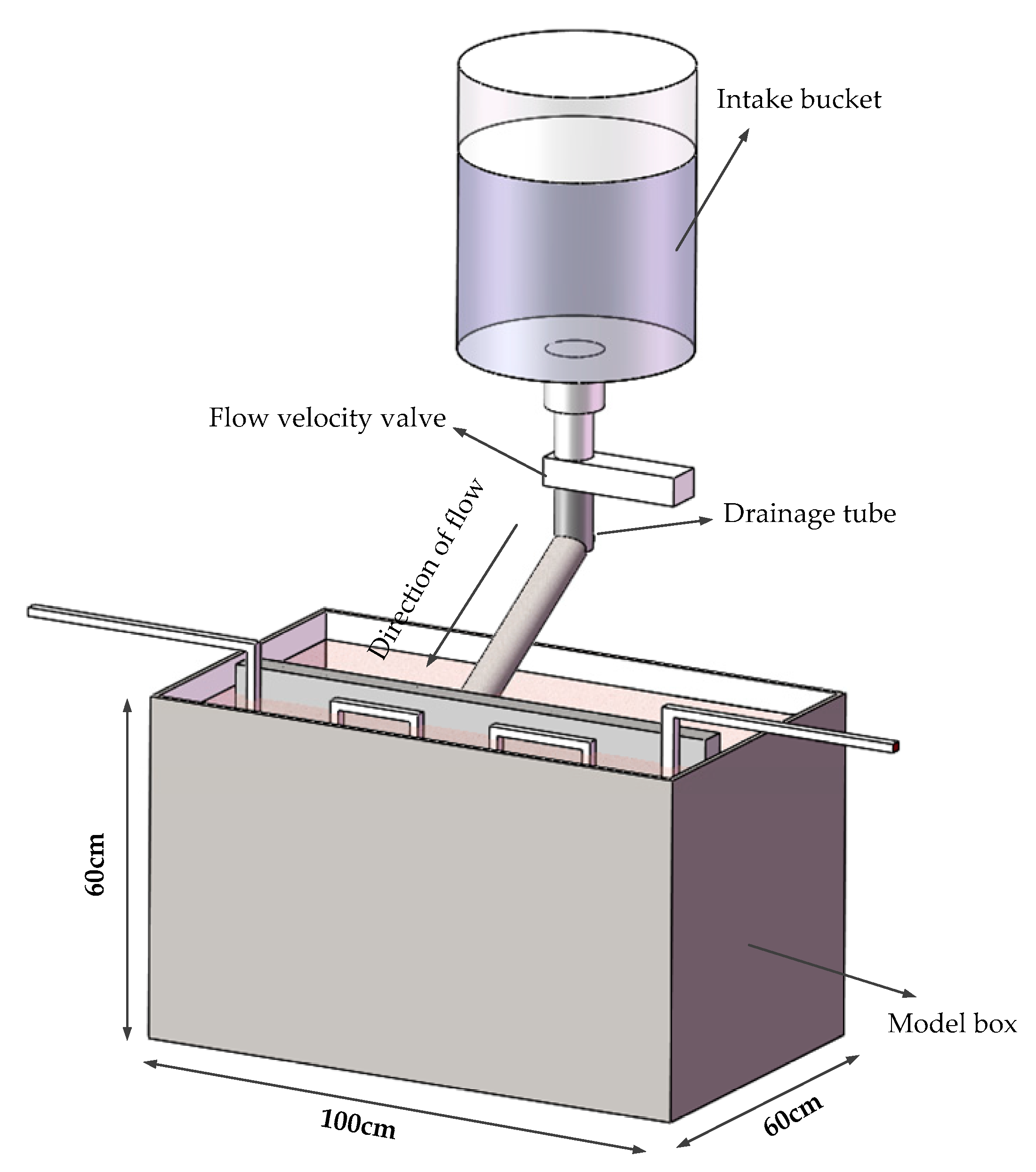
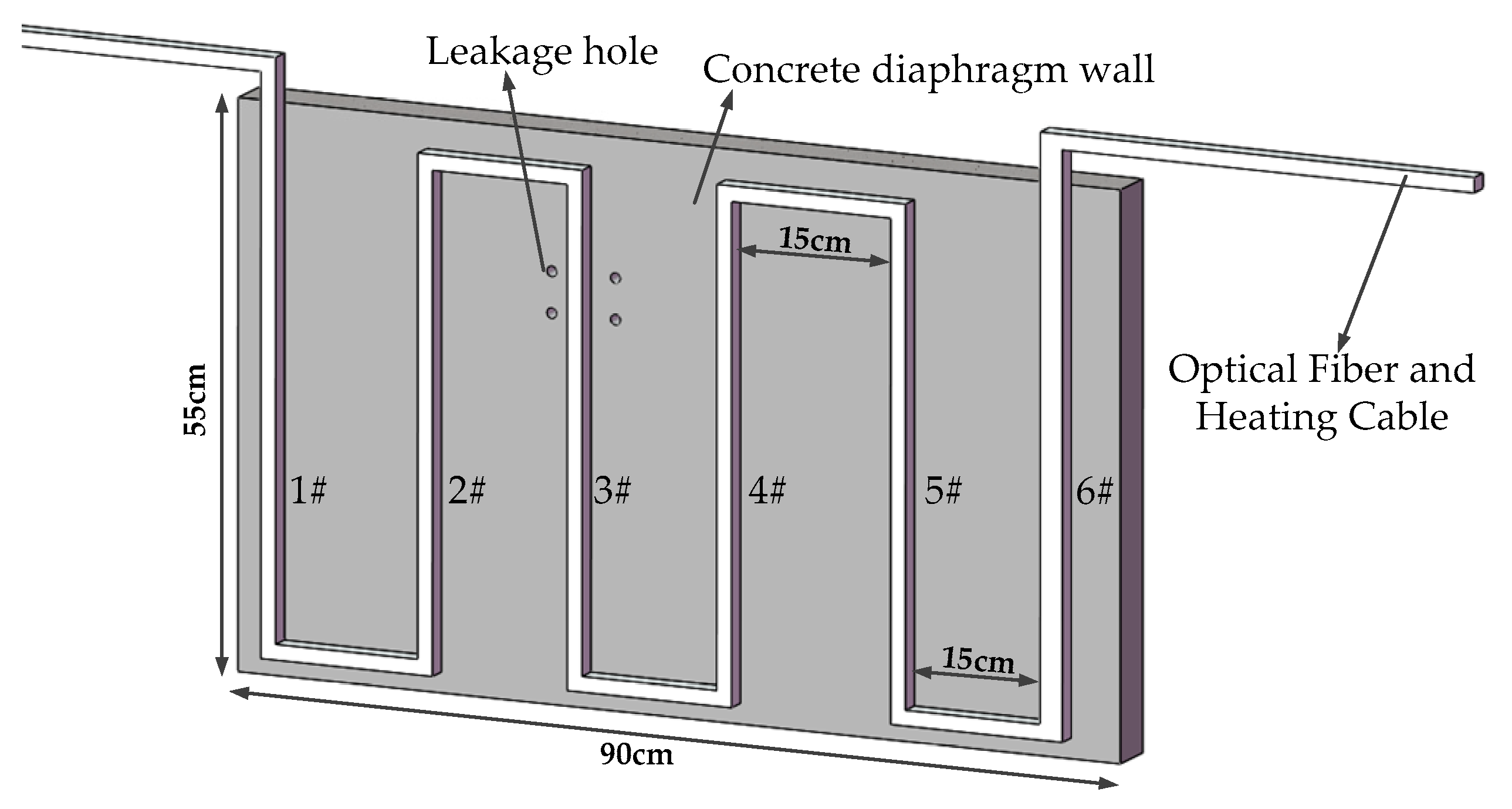



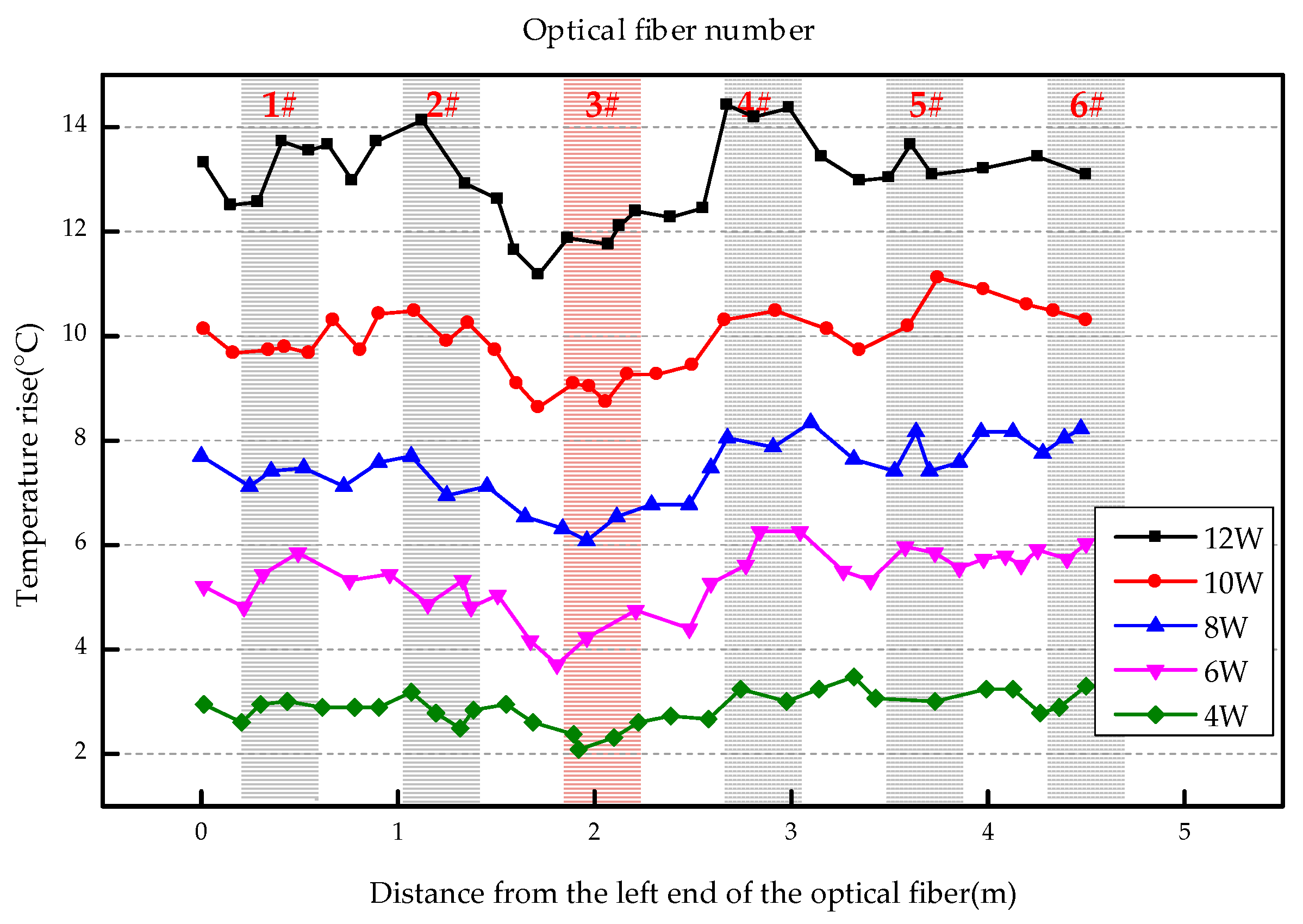


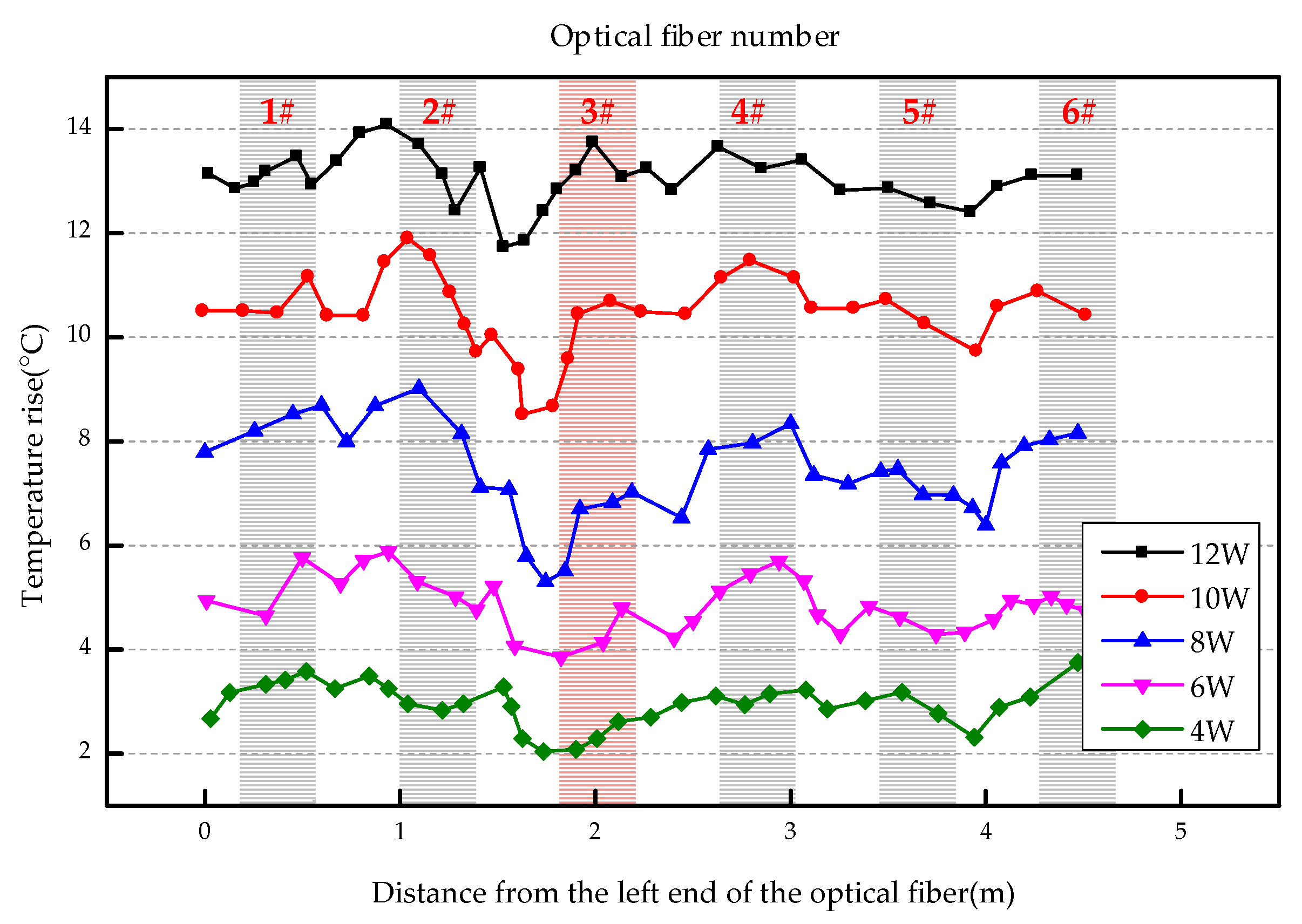

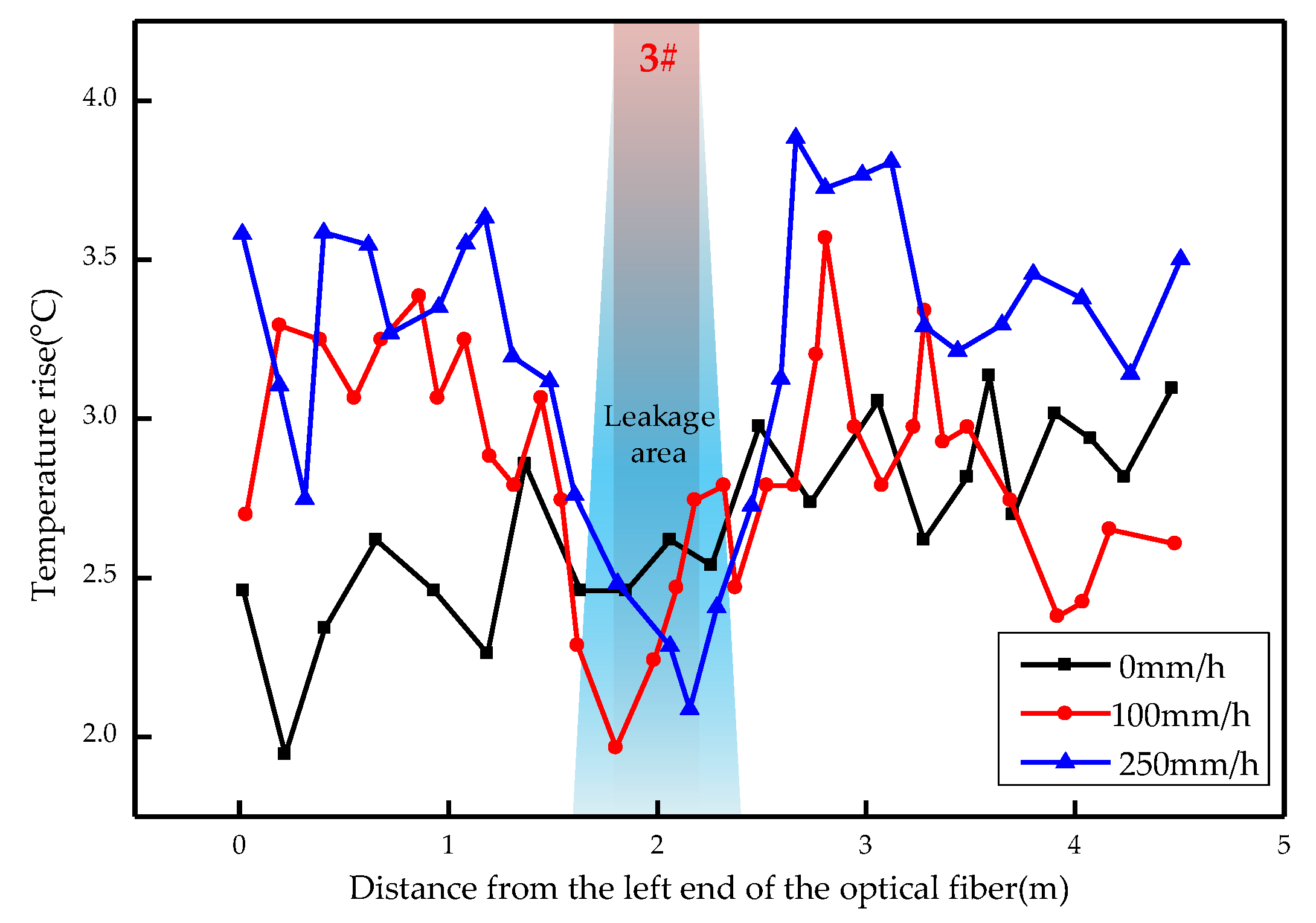
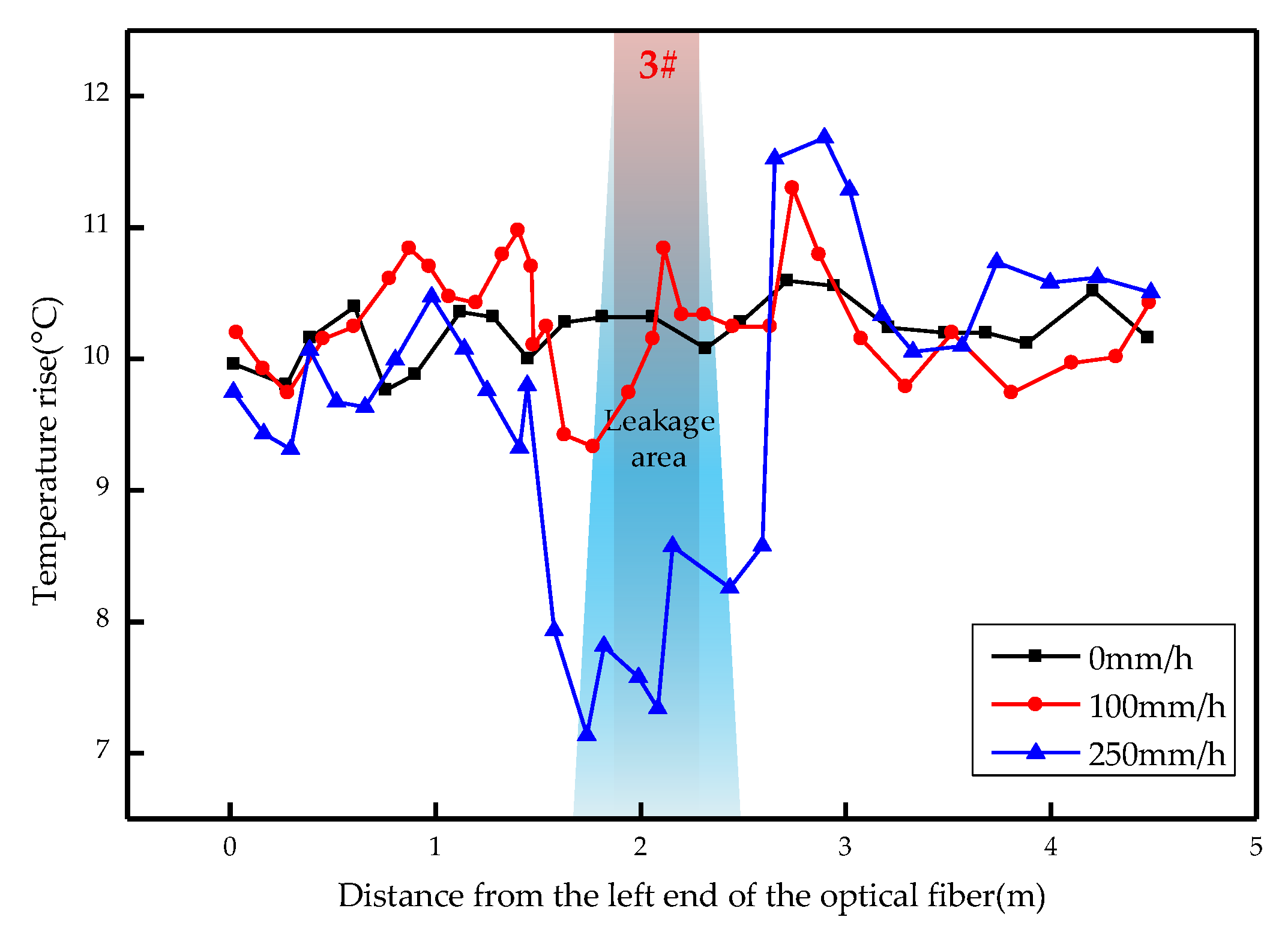


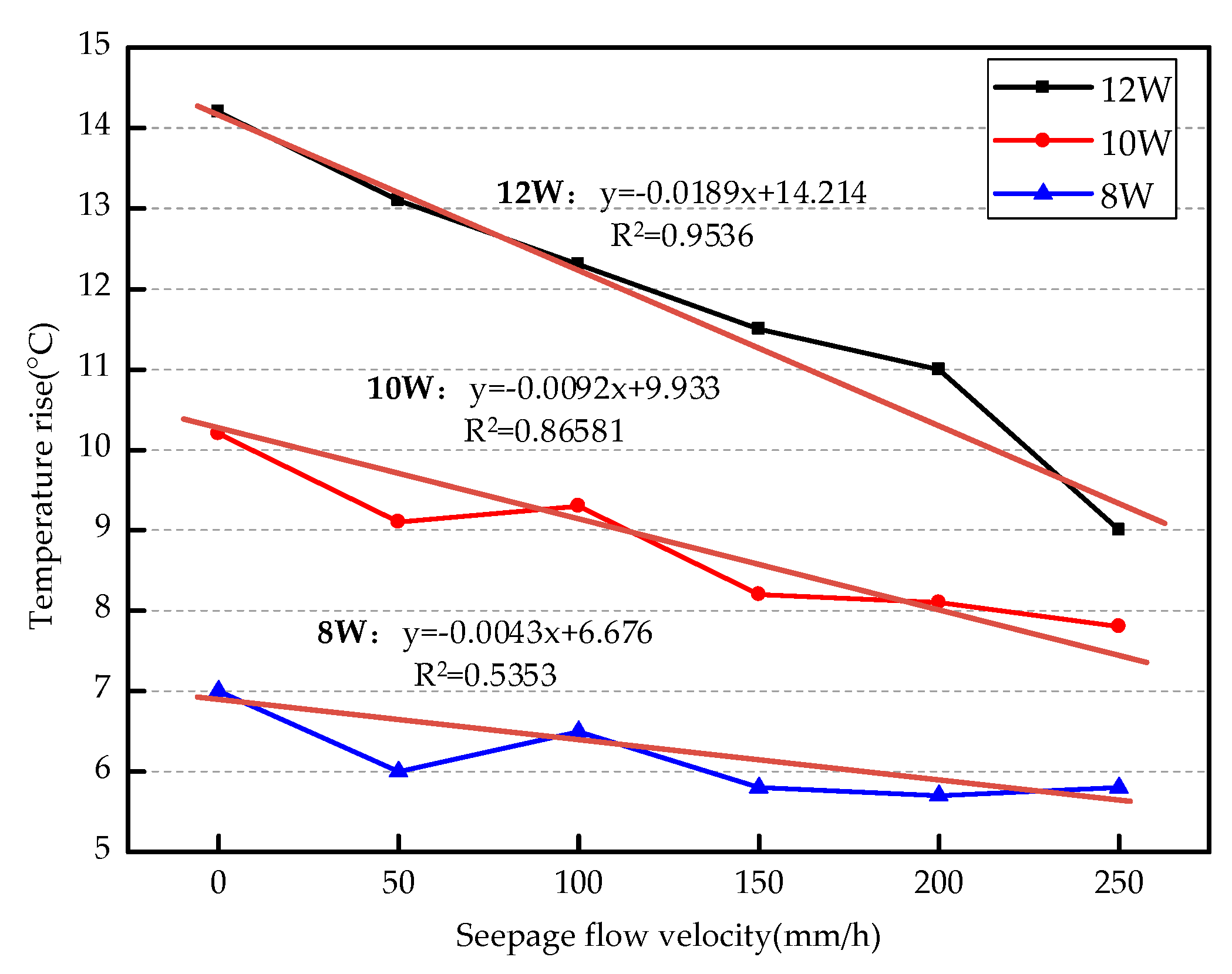
| Material | Defined Temperature (°C) | Rated Power (W) | Rated Current (A) | Diameter (mm) | Line Resistivity (Ω/m) |
|---|---|---|---|---|---|
| Galvanized copper wire | 65 | 10/15/25/30 | 40 | 8 | 67 |
| Material | Rated Power | Input Voltage | Output Voltage | Frequency | Insulation Grade |
|---|---|---|---|---|---|
| Full copper coil | 200VA-40KVA | AC 220 V | AC 0–250 V | 50–60 Hz | A |
| Measuring Distance | Measuring Temperature Range | Accuracy | Temperature Resolution | Spatial Resolution |
|---|---|---|---|---|
| 1-16km | −40–120 °C | ±0.3 °C | 0.1 °C | 0.5–3 m |
| 4 W/m | 6 W/m | 8 W/m | 10 W/m | 12 W/m |
|---|---|---|---|---|
| 90.48 V | 110.82 V | 127.96 V | 143.07 V | 156.72 V |
© 2019 by the authors. Licensee MDPI, Basel, Switzerland. This article is an open access article distributed under the terms and conditions of the Creative Commons Attribution (CC BY) license (http://creativecommons.org/licenses/by/4.0/).
Share and Cite
Liu, T.; Sun, W.; Kou, H.; Yang, Z.; Meng, Q.; Zheng, Y.; Wang, H.; Yang, X. Experimental Study of Leakage Monitoring of Diaphragm Walls Based on Distributed Optical Fiber Temperature Measurement Technology. Sensors 2019, 19, 2269. https://doi.org/10.3390/s19102269
Liu T, Sun W, Kou H, Yang Z, Meng Q, Zheng Y, Wang H, Yang X. Experimental Study of Leakage Monitoring of Diaphragm Walls Based on Distributed Optical Fiber Temperature Measurement Technology. Sensors. 2019; 19(10):2269. https://doi.org/10.3390/s19102269
Chicago/Turabian StyleLiu, Tao, Wenjing Sun, Hailei Kou, Zhongnian Yang, Qingsheng Meng, Yuqian Zheng, Haotong Wang, and Xiaotong Yang. 2019. "Experimental Study of Leakage Monitoring of Diaphragm Walls Based on Distributed Optical Fiber Temperature Measurement Technology" Sensors 19, no. 10: 2269. https://doi.org/10.3390/s19102269




